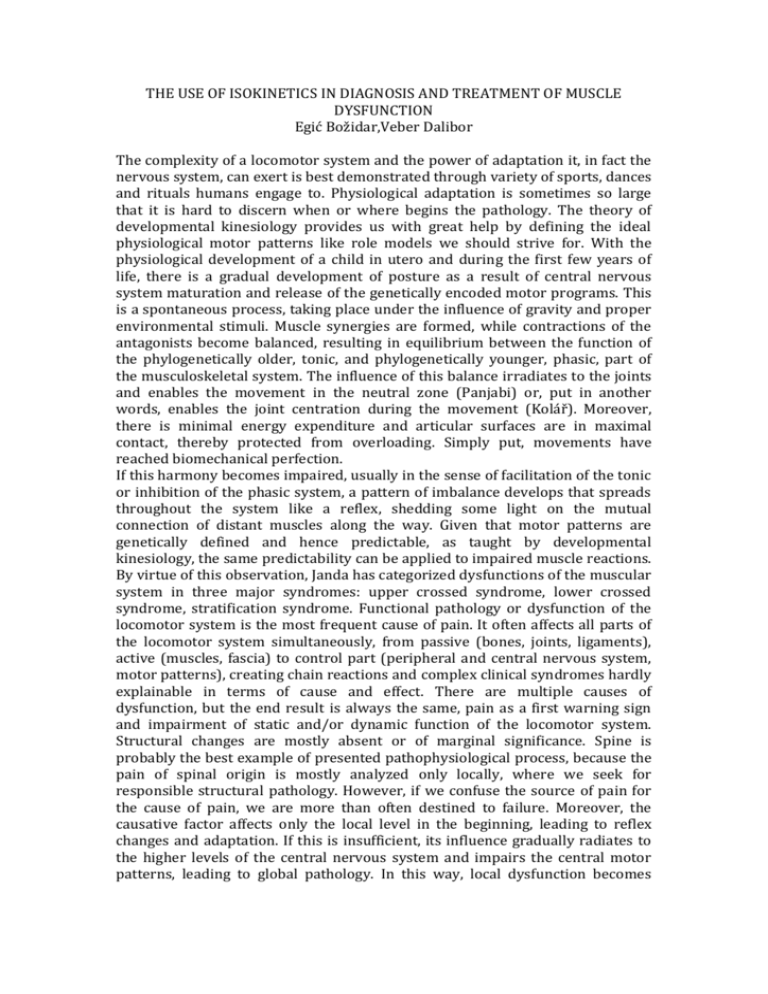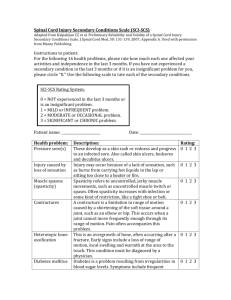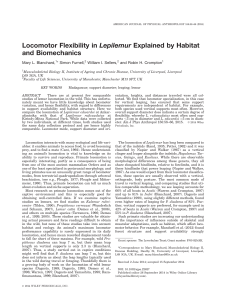Isokinetic treatment of muscle dysfunction
advertisement

THE USE OF ISOKINETICS IN DIAGNOSIS AND TREATMENT OF MUSCLE DYSFUNCTION Egić Božidar,Veber Dalibor The complexity of a locomotor system and the power of adaptation it, in fact the nervous system, can exert is best demonstrated through variety of sports, dances and rituals humans engage to. Physiological adaptation is sometimes so large that it is hard to discern when or where begins the pathology. The theory of developmental kinesiology provides us with great help by defining the ideal physiological motor patterns like role models we should strive for. With the physiological development of a child in utero and during the first few years of life, there is a gradual development of posture as a result of central nervous system maturation and release of the genetically encoded motor programs. This is a spontaneous process, taking place under the influence of gravity and proper environmental stimuli. Muscle synergies are formed, while contractions of the antagonists become balanced, resulting in equilibrium between the function of the phylogenetically older, tonic, and phylogenetically younger, phasic, part of the musculoskeletal system. The influence of this balance irradiates to the joints and enables the movement in the neutral zone (Panjabi) or, put in another words, enables the joint centration during the movement (Kolář). Moreover, there is minimal energy expenditure and articular surfaces are in maximal contact, thereby protected from overloading. Simply put, movements have reached biomechanical perfection. If this harmony becomes impaired, usually in the sense of facilitation of the tonic or inhibition of the phasic system, a pattern of imbalance develops that spreads throughout the system like a reflex, shedding some light on the mutual connection of distant muscles along the way. Given that motor patterns are genetically defined and hence predictable, as taught by developmental kinesiology, the same predictability can be applied to impaired muscle reactions. By virtue of this observation, Janda has categorized dysfunctions of the muscular system in three major syndromes: upper crossed syndrome, lower crossed syndrome, stratification syndrome. Functional pathology or dysfunction of the locomotor system is the most frequent cause of pain. It often affects all parts of the locomotor system simultaneously, from passive (bones, joints, ligaments), active (muscles, fascia) to control part (peripheral and central nervous system, motor patterns), creating chain reactions and complex clinical syndromes hardly explainable in terms of cause and effect. There are multiple causes of dysfunction, but the end result is always the same, pain as a first warning sign and impairment of static and/or dynamic function of the locomotor system. Structural changes are mostly absent or of marginal significance. Spine is probably the best example of presented pathophysiological process, because the pain of spinal origin is mostly analyzed only locally, where we seek for responsible structural pathology. However, if we confuse the source of pain for the cause of pain, we are more than often destined to failure. Moreover, the causative factor affects only the local level in the beginning, leading to reflex changes and adaptation. If this is insufficient, its influence gradually radiates to the higher levels of the central nervous system and impairs the central motor patterns, leading to global pathology. In this way, local dysfunction becomes global and spine can be the cause of the problem, but also just one link in a chain of global dysfunction of the locomotor system. Dysfunction of the locomotor system is a complex term. It is defined as imbalance (facilitation or inhibition) between motor units of single or group of muscles and becomes visible through inadequate motor stereotypes that lead to inadequate positioning of articular surfaces during the movement. Described pathological adaptation is associated with reflex changes which can lead to many symptoms, from pain to visceral problems. In treatment it is important to find the root of the problem that usually hides far away from the source of pain. Along numerous diagnostic and kinesitherapeutic procedures, isokinetic diagnosis and training can be very helpful as the root of the problem frequently lays in the muscle imbalance. By measuring the parameters of isokinetic muscle contraction, using the isokinetic dynamometer, one can determine the muscle strength, work and endurance. These results are later analyzed and used for planning and performing isokinetic training. The advantages of isokinetic training are efficiency, safety, reproducibility and comparability. The drawbacks are nonphysiological contraction (constant angular speed), impossibility to achieve neural reactions, motor learning and complexity of the movement (3D). The scope of the use of isokinetics is wide, from prevention, rehabilitation after trauma or surgery, various pain syndromes of muscular origin, to sports training. Contraindications are few, the use is simple as is the storing of data, an important consideration regarding the limited amount of time available for a patient. In spite of all the benefits of isokinetics, it has to be viewed as just one part of the rehabilitation process. The complexity of the locomotor system and the chain reactions which result from its dysfunction require multidisciplinary approach in the treatment. KEY WORDS: isokinetics, dysfunction, locomotor system, chain reaction, pain syndrome, rehabilitation, developmental kinesiology









